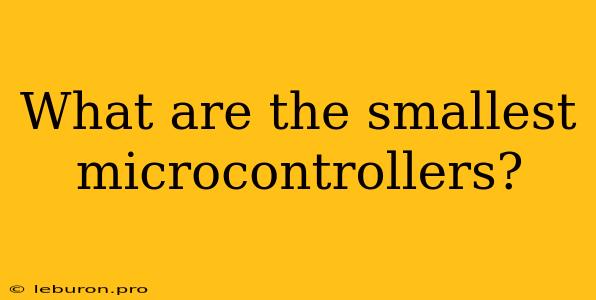The world of microcontrollers is vast and ever-evolving, offering solutions for a multitude of applications. From controlling household appliances to powering sophisticated industrial machinery, microcontrollers are the brains behind countless devices. But what about the tiny titans of this world, the smallest microcontrollers? These diminutive chips pack remarkable power into incredibly small packages, opening up new possibilities for miniaturization and integration.
Unraveling the Tiny Giants: A Journey into the Realm of Smallest Microcontrollers
To understand the significance of small microcontrollers, we must first define what we mean by "small." The size of a microcontroller is often measured in terms of its package size, which can vary greatly. Smallest microcontrollers can be as small as a few millimeters squared, often featuring chip-scale packages (CSP) or wafer-level chip-scale packages (WLCSP). These tiny packages offer several advantages, including:
- Miniaturization: The ability to create smaller and more compact devices, enabling integration into tight spaces.
- Reduced Cost: Smaller packages often translate to lower manufacturing costs, making them appealing for budget-conscious applications.
- Increased Density: The ability to pack more functionality into a smaller space, leading to more complex and feature-rich devices.
Delving Deeper: Exploring the Dimensions of Smallest Microcontrollers
The quest for smallest microcontrollers is driven by the constant demand for miniaturization across various industries. Here are some key factors influencing the size of microcontrollers:
- Core Architecture: The underlying architecture of the microcontroller, such as the number of cores and their complexity, plays a crucial role in determining the overall chip size.
- Memory Capacity: The amount of on-chip memory (RAM and flash) required by an application directly influences the footprint of the microcontroller.
- Peripheral Integration: The inclusion of integrated peripherals, such as analog-to-digital converters (ADCs), timers, and communication interfaces, adds to the overall package size.
- Packaging Technology: Advanced packaging technologies, like CSP and WLCSP, are essential for achieving smallest microcontroller sizes, minimizing the space occupied by the chip and its connections.
Unveiling the Leaders: Notable Examples of Smallest Microcontrollers
The landscape of smallest microcontrollers is constantly evolving, with manufacturers pushing the boundaries of miniaturization. Here are some notable examples of these tiny powerhouses:
- Microchip Technology's PIC10F200: This microcontroller boasts a 6-pin package, making it one of the smallest commercially available microcontrollers. Its small size and low-power consumption make it ideal for applications like wearable sensors and IoT devices.
- STMicroelectronics STM8S003F3: This microcontroller comes in a tiny 3x3mm QFN package, offering an impressive combination of size and functionality. It is well-suited for applications like automotive sensors, medical devices, and industrial automation.
- Texas Instruments MSP430G2231: This microcontroller features a 10-pin TSSOP package, making it a compact option for various applications. Its low-power consumption and flexibility make it ideal for battery-powered devices.
- NXP Semiconductors LPC1114: This microcontroller comes in a small 10-pin QFN package, offering a balance of performance and size. It is suitable for applications like smart home devices, industrial control systems, and robotics.
The Advantages of Embracing Smallest Microcontrollers
The use of smallest microcontrollers offers a wide range of benefits across various industries. Here are some key advantages:
- Reduced Footprint: Small microcontrollers enable the creation of compact and portable devices, allowing for seamless integration into confined spaces.
- Lower Cost: Smaller package sizes generally lead to lower manufacturing costs, making them more affordable for a wider range of applications.
- Improved Performance: Advanced packaging technologies used for smallest microcontrollers often offer improved performance and efficiency, enhancing the overall device capabilities.
- Increased Flexibility: Smaller microcontrollers can be integrated into more diverse designs, enabling the development of unique and innovative solutions.
The Future of Smallest Microcontrollers: Looking Ahead
The quest for smaller and more powerful microcontrollers is far from over. The industry is constantly innovating, exploring new packaging technologies and chip architectures to push the boundaries of miniaturization. We can expect to see even smaller smallest microcontrollers in the near future, opening up possibilities for even more compact, sophisticated, and integrated devices.
Smallest microcontrollers are revolutionizing the way we design and build devices, enabling us to create smaller, more efficient, and feature-rich solutions for a wide range of applications. As technology continues to advance, these tiny titans will continue to play an increasingly vital role in shaping the future of electronics and beyond.
